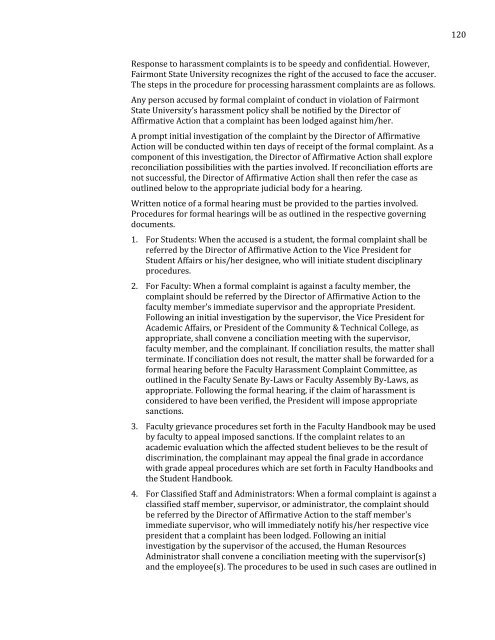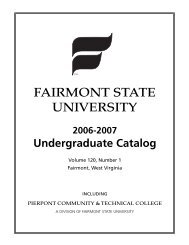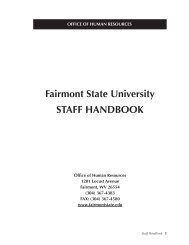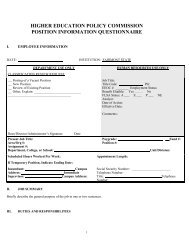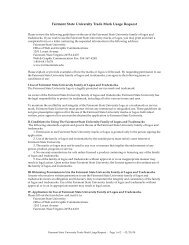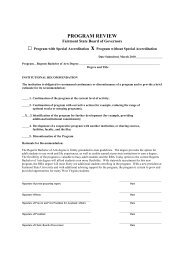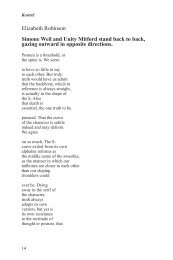Faculty Handbook - Fairmont State University
Faculty Handbook - Fairmont State University
Faculty Handbook - Fairmont State University
You also want an ePaper? Increase the reach of your titles
YUMPU automatically turns print PDFs into web optimized ePapers that Google loves.
120<br />
Response to harassment complaints is to be speedy and confidential. However,<br />
<strong>Fairmont</strong> <strong>State</strong> <strong>University</strong> recognizes the right of the accused to face the accuser.<br />
The steps in the procedure for processing harassment complaints are as follows.<br />
Any person accused by formal complaint of conduct in violation of <strong>Fairmont</strong><br />
<strong>State</strong> <strong>University</strong>’s harassment policy shall be notified by the Director of<br />
Affirmative Action that a complaint has been lodged against him/her.<br />
A prompt initial investigation of the complaint by the Director of Affirmative<br />
Action will be conducted within ten days of receipt of the formal complaint. As a<br />
component of this investigation, the Director of Affirmative Action shall explore<br />
reconciliation possibilities with the parties involved. If reconciliation efforts are<br />
not successful, the Director of Affirmative Action shall then refer the case as<br />
outlined below to the appropriate judicial body for a hearing.<br />
Written notice of a formal hearing must be provided to the parties involved.<br />
Procedures for formal hearings will be as outlined in the respective governing<br />
documents.<br />
1. For Students: When the accused is a student, the formal complaint shall be<br />
referred by the Director of Affirmative Action to the Vice President for<br />
Student Affairs or his/her designee, who will initiate student disciplinary<br />
procedures.<br />
2. For <strong>Faculty</strong>: When a formal complaint is against a faculty member, the<br />
complaint should be referred by the Director of Affirmative Action to the<br />
faculty member's immediate supervisor and the appropriate President.<br />
Following an initial investigation by the supervisor, the Vice President for<br />
Academic Affairs, or President of the Community & Technical College, as<br />
appropriate, shall convene a conciliation meeting with the supervisor,<br />
faculty member, and the complainant. If conciliation results, the matter shall<br />
terminate. If conciliation does not result, the matter shall be forwarded for a<br />
formal hearing before the <strong>Faculty</strong> Harassment Complaint Committee, as<br />
outlined in the <strong>Faculty</strong> Senate By-Laws or <strong>Faculty</strong> Assembly By-Laws, as<br />
appropriate. Following the formal hearing, if the claim of harassment is<br />
considered to have been verified, the President will impose appropriate<br />
sanctions.<br />
3. <strong>Faculty</strong> grievance procedures set forth in the <strong>Faculty</strong> <strong>Handbook</strong> may be used<br />
by faculty to appeal imposed sanctions. If the complaint relates to an<br />
academic evaluation which the affected student believes to be the result of<br />
discrimination, the complainant may appeal the final grade in accordance<br />
with grade appeal procedures which are set forth in <strong>Faculty</strong> <strong>Handbook</strong>s and<br />
the Student <strong>Handbook</strong>.<br />
4. For Classified Staff and Administrators: When a formal complaint is against a<br />
classified staff member, supervisor, or administrator, the complaint should<br />
be referred by the Director of Affirmative Action to the staff member's<br />
immediate supervisor, who will immediately notify his/her respective vice<br />
president that a complaint has been lodged. Following an initial<br />
investigation by the supervisor of the accused, the Human Resources<br />
Administrator shall convene a conciliation meeting with the supervisor(s)<br />
and the employee(s). The procedures to be used in such cases are outlined in


